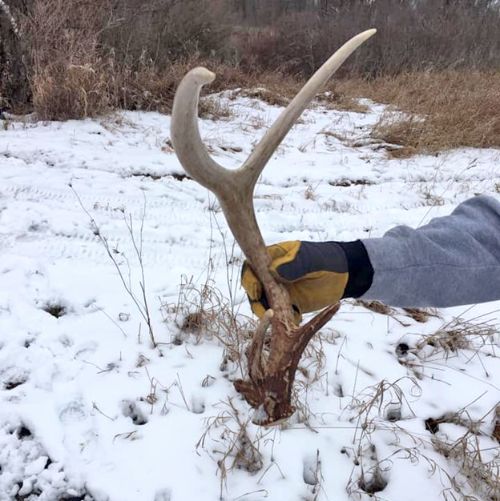Hunting antler sheds: A fun and informative winter pastime
Finding deer sheds is a great way to get outside and enjoy winter while learning valuable information about the deer in your area.

Michigan has an abundant deer population, and many people enjoy searching or hunting for antler sheds as a winter outdoor activity. The antler cycle is controlled by photo period, or day length. Male deer grow antlers rapidly in spring and summer. After the breeding season, as the days get shorter, the amount of the reproductive hormone testosterone drops.
Testosterone controls the antler cycle; when testosterone levels drop, specialized cells called osteoclasts are activated. These osteoclasts eat away at the pedicle, or base of the deer’s antlers, which cause the antlers to become weak and eventually fall off. This cycle occurs annually in deer. The best time to search for antler sheds is between mid-January and March.
Here are some tips for a successful antler shed hunt.
- Look along deer trails. Deer trails are a great place to find sheds because the deer are traveling along these routes, likely bounding or jumping over downed logs, fences or small streams. The impact of landing may help antlers to drop. Also, look in areas on the trail where brush is thick. The thick brush may pull at the antlers, helping them to drop.
- Areas that offer a feeding site can also be areas where sheds can be found. During the winter months, areas that offer abundant and quality nutrition will be a natural congregation site, which increases the odds that sheds can be found.
- Deer sheds pose very little risk in spreading chronic wasting disease. Wipe any organic material from sheds and always practice good hand hygiene after handling antler sheds.
Deer antler sheds can give you valuable information about the deer herd in your area as well. Antler size is dependent upon the animals’ age, the quality of nutrition it is receiving, and its genetics.
Evaluating antler sheds can give you an idea of the age structure of the bucks in the area. A one-year-old deer will have thin beams, or the central stem of the antler, and the spread is usually inside the ears of the animal, whereas a four-year-old deer will have thicker, heavy antlers with good bases and multiple points. The spread will expand beyond the ears.
Good nutrition is essential for antler growth. Regardless of age, a buck needs an adequate intake of protein for growth and development; as the deer ages, its protein requirements will decrease because it is using less of the dietary protein for body development therefore it can be utilized in antler growth.
Additionally, deer require vitamins and minerals, calcium and phosphorus in particular for antler growth. While the antlers are growing, the deer mobilizes calcium and phosphorus from skeletal sites, such as rib bones, and then uses it in antler development. If the soil in your area doesn’t contain the proper amounts of vitamins and minerals, antlers may not develop to their full potential.
Lastly, genetics play a role in antler development. The buck will inherit physical characteristics from its parents; the combination of the parents presents a “genetic potential.” It is difficult to measure how influential genetics are in antler development due to the various external factors that impact antler growth—nutrition, stress, environment, and overall animal health.
For more information about deer management, chronic wasting disease, tips and tools for hunters and venison consumers, and other deer related topics, visit Michigan State University Extension’s Chronic Wasting Disease website.



 Print
Print Email
Email